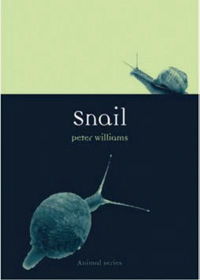“Snail” by Peter Williams.
Reaktion Books, 2009 ISBN 978-1-86189-528-8 167pp, paperback. £9.99
Mollusc World Issue 23, page 28.
 There are many books which provide an introduction to molluscs, and to the interaction between molluscs and man. Most concentrate on shells rather than the animals which produce them, many deal exclusively with marine molluscs, ignoring their land and freshwater relations. It is therefore a pleasure to find a book which redresses the balance with a greater coverage of both non-marine snails and living molluscs.
There are many books which provide an introduction to molluscs, and to the interaction between molluscs and man. Most concentrate on shells rather than the animals which produce them, many deal exclusively with marine molluscs, ignoring their land and freshwater relations. It is therefore a pleasure to find a book which redresses the balance with a greater coverage of both non-marine snails and living molluscs.
The ‘Snail’ of the title is very broadly used to include various ‘sea-snails’, I suspect through the publisher’s remit and I can’t help wondering whether the book could have more usefully concentrated entirely on the non-marine as much of the marine material is well covered already. The only restriction seems to be to gastropods without reference to bivalves, cephalopods etc, again presumably to tie in to the title.
The book is well written, informative without being over technical, equally accessible to anyone without a background knowledge of molluscs and to those with an existing interest. It does however at times, to my mind, anthropomorphise the subject – though this is perhaps just a matter of style.
There are many intriguing facts in the book. In have not previously come across the 18th century Italian scientist Lazzaro Spallanzani studying repair and regeneration by removing part of a snail’s head, showing that it could regrow and later transplanting “the face of one snail on to the body of another”. Neither had I seen previous reference to the 1781 ‘Kelp Riots of Stronsay’ when local people protested after the removal of mkelp reduced the population of limpets which they regularly ate. The book is fully referenced so it is easy to follow up on any of the information which catches one’s interest, or on any of the literary quotations scattered throughout the text. It is also pleasing to see that the Conchological Society features in the “list of websites and associations”.
The book is well illustrated throughout from both scientific ans artistic sources – from 16th century woodcuts to 20th century architecture. I particularly liked the 1887 American political cartoon showing Uncle Sam wearing spurs trying to urge on a reluctant Congress in the form of a snail.
Unfortunately there are a number of glaring errors. The legendary ‘Samartian Snail’ appears as the ‘Samaritan Snail’. Martin Lister’s engraving of the land snail Megalobulimus oblongus together with its egg and hatchling is labelled as “a whelk, Buccinium” – mislead undoubtedly by the original caption “Buccinium...” though this is pre-binomial and bears no relation to the shell’s scientific name. We also read of Hugh Cumming (sic) and Lieutenant Frambly (sic) instead of Cuming and Frembly; strangely the reference cited for this is a website reference to “Orchidologist, Hugh Cuming” rather than Peter Dance’s “A History of Shell Collecting” which is cited elsewhere so presumably was available to the author.
I enjoyed reading this book and can recommend it. With such a modest price it will surely sell well.
Kevin Brown
